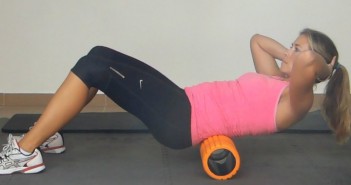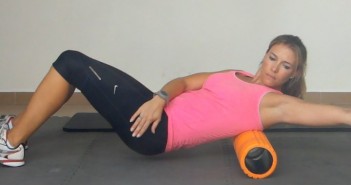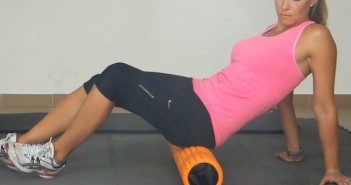The Foam Roller Lower Back Quadratus Lumborum (QL) Exercise is a great self-massage exercise that will give your lower back a deep and effective sports massage, thus improving the health and quality of your muscle tissue and helping you to perform better. It will also alleviate soreness and make your muscles feel better.
The quadratus lumborum is a common source of lower back pain, especially for golfers. The QL connects the pelvis to the spine and, when the lower fibres of the erector spinae are weak or inhibited (as they often are in the case of habitual seated computer use and/or the use of a lower back support in a chair), the two QLs pick up the slack, as it were, helping to extend the lower back.
Constant contraction while seated, or in golf address position, can overuse the QLs, resulting in muscle fatigue. A constantly contracted QL, like any other muscle, will experience decreased blood flow, and, in time, adhesions (knots) in the muscle and fascia may develop, the result of which is muscle spasm. This problem is exacerbated by poor posture, which places greater stress on the QLs by shifting your body weight forward, forcing the erector spinae, QLs, multifidi, and especially the levator scapulae to work harder in golf address, seated and standing positions to maintain an erect torso and neck.
The foam roller overloads the muscle tissues through compression, causing your nerves to relax, signalling muscle spasms to shut off, pumping blood and and getting your lymphatic system flowing, to help muscle recovery and regeneration. You’ll work out those knots (muscle adhesions) in your muscles caused either by inactivity, by the repetitive strain of the golf swing, or by walking a tough golf course. This will enable you to stretch the muscles back out to their original length, making them more pliable and functional.
The Foam Roller Lower Back (QL) Exercise can be performed both before and after playing golf, practising on the range, or other physical activity. It’s also great after sitting in the same position for a while, and can be enjoyed anywhere and anytime you feel tight and in need of a massage, such as while watching television or before bedtime.
Equipment
This exercise requires a foam roller, also referred to as a foam roll.
For more information on the foam roller and its benefits, see An Introduction to the Foam Roller – The Golfer’s Best Friend.
Steps
- Start by lying on your side, leaning back about 45 degrees, with a foam roller under the side of your mid-back, just below your rib cage. Use one forearm and both feet to help support your weight, but place as much weight on the foam roller as you can tolerate. Keep your abdominal muscles engaged.
- Roll along the side of your torso, from just below your rib cage down to the top of your pelvis (just below your belt line).
- Repeat with the roller under the other side of your back.
Work the foam roller back and forth, gliding the side of your lower back over the foam roller, for 30 to 60 seconds on each side. As you work you’ll discover muscle spasms and tender pressure points, hold on each pressure point for an additional 30 seconds until the muscle releases from spasm.
The first time you perform this exercise, it might be a little painful, just like a professional sports massage would be, but that’s just a sign that you stand to benefit enormously from it. After the first few sessions, it will start to become considerably easier and more comfortable. The better it feels, and the less it hurts, the better the quality of your muscle tissue.
Only go as deep as you can tolerate, and slowly build up the amount of time you spend on this exercise.
If you have any questions or comments about this or other articles on Golf Loopy, please send us an email.
You May Also Like…
Golf Performance Programmes – the most effective golf-specific fitness regimens on the planet, guaranteed to make you a better golfer!
There are a number of other golf recovery and regeneration exercises in the Golf Loopy Train like a Champion System.
An Introduction to the Foam Roller – The Golfer’s Best Friend.
Introduction to the Swing like a Champion System.
Golf Anatomy and Kinesiology, a collection of articles describing the roles of the muscles involved in the golf swing.
The Role of the Erector Spinae in the Golf Swing.
The Role of the Levator Scapulae in the Golf Swing.
The Role of the Multifidi in the Golf Swing.



